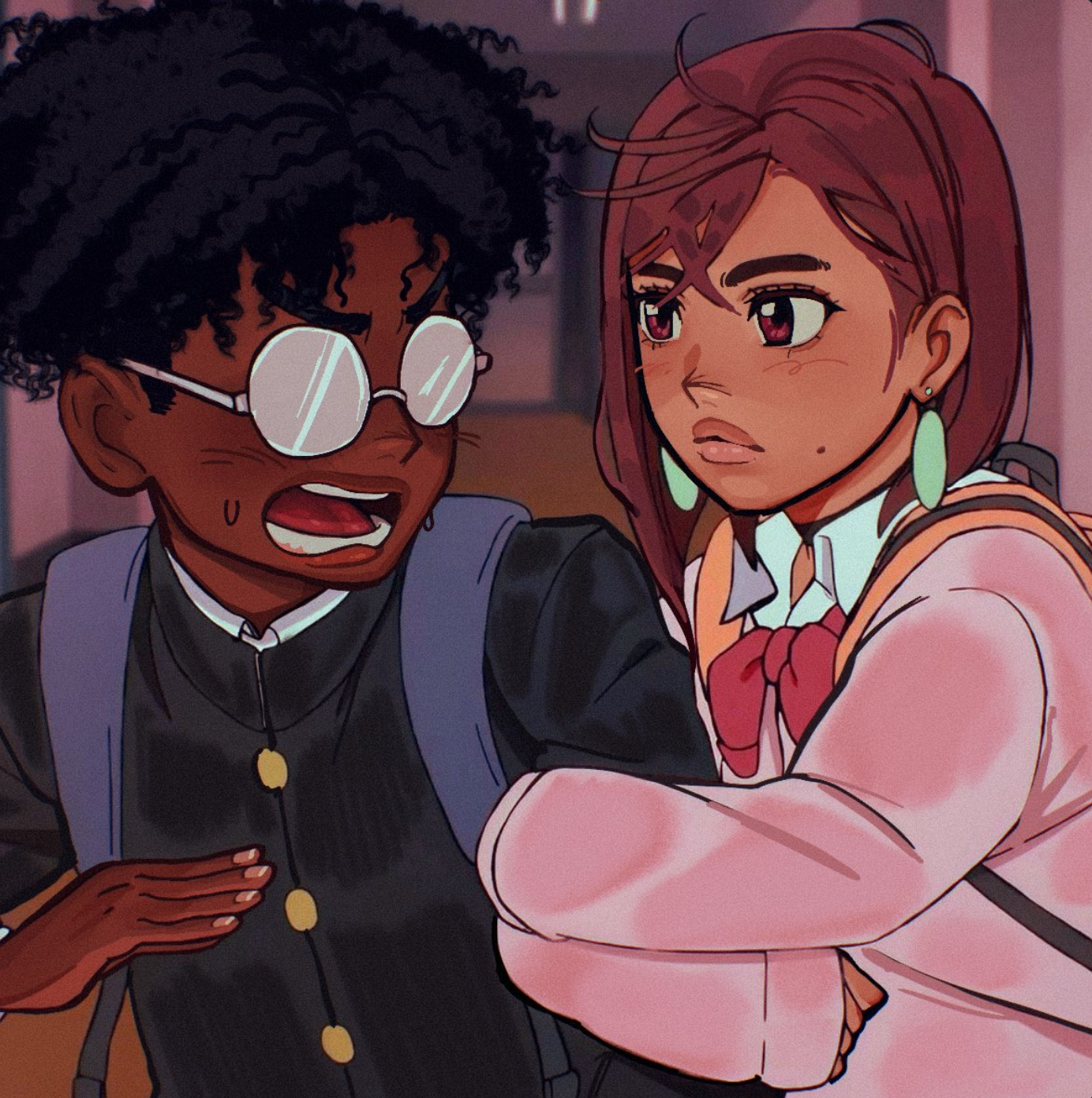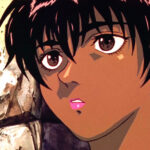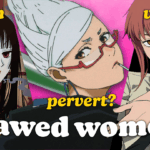An argument over fan art sparks conversations about representation, hypocrisy, and how fans interact with the franchises they love.
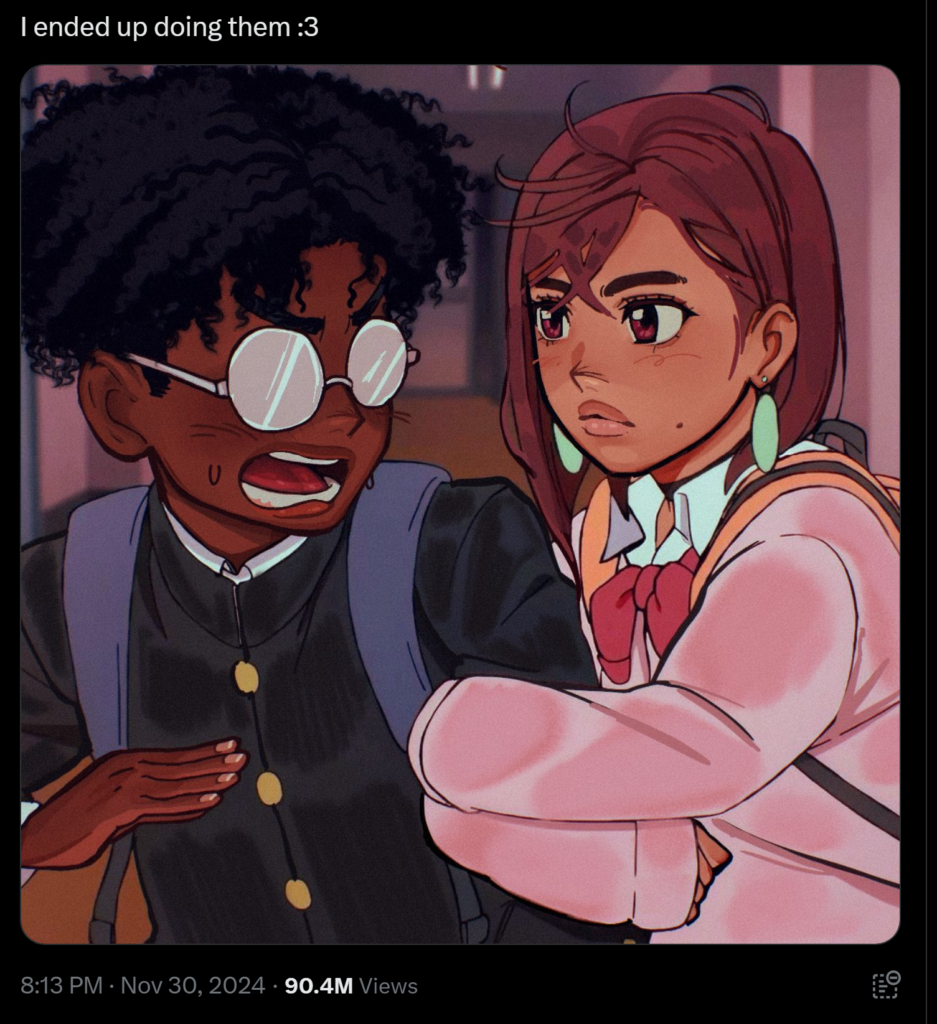
Quick Note: The Anime Tea is running a fundraiser on Tiltify for the Palestine Children Relief Fund (PCRF) that will be open from February 23-April 23, 2025. To help please visit this link: https://tiltify.com/@theanimetea/theanimetea-fundraising-for-palestine.
The temporary ceasefire in Gaza is not the end of the fight to protect the children of Palestine who still desperately need help and aid. To learn more about the PCRF please visit their website here: https://www.pcrf.net/.
Update June 2025: WE REACHED OUR GOAL OF $200!! THANK YOU FOR YOUR SUPPORT
It’s mid-December, you log onto “formerly Twitter” because you want to check on the mental health of your moots & oomfs that haven’t abandoned the platform yet and you get bombarded with heated opinions over a fan art by an allegedly 16-year-old artist who drew Okarun and Momo from Dandadan as Black and Latina respectively. An image which the English voice actor for Okarun, A.J. Beckles, uses as his profile picture causing the discourse to explode. The image gets over 90 million impressions in the app alone. Insults and arguments are flying across retweets and comments the further you scroll. And you start to realize the discourse stems into two main groups.
One side is insisting that this particular fan art is racist as it erases Japanese ethnic features and insinuates that the racebent versions of these characters are better. While the other argues that the fan art is harmless, made out of appreciation of the original characters, and is a way of self expression. Stuck in the onslaught of text and images, you struggle to understand how a single image has caused such divisive discourse.
But what if I told you this wasn’t the first time this particular argument has turned anime fandom on it’s head? In 2022, user @Soulkinglives on Twitter posted Jujutsu Kaisen fanart with racebent versions of Gojo and Yuji which caused a similar online battle. In 2021, Thumin made a fan art where she drew herself as Kiki from Kiki’s Delivery Service which elicited a round of hateful and racist drawings by other users. Also in 2021, Youtuber Veridis Joe made a video exploiting the hatred and racism prevalent towards black cosplayers dressing as anime characters. A plight that has existed for years as cosplayers fight harassment over not having the same skin tone as the characters they are replicating. Even more fandoms across mediums have each faced similar conflicts over character fan art and cosplays. Every time a black cosplayer or artist wants to show off their work, there is some level of hateful rhetoric being spewed towards them in response.
Yet in these same fandoms where people praise artists renditions of Spidersona’s, gender-bent versions of popular anime men, and the all mighty Brazilian Miku who is praised for uniting the world and who recently took over the internet just several months before the Dandadan fan art controversy. It makes you wonder, are pockets of the anime fandom hypocritical or misguided? Or is all of this being blown way out of proportion?
What is Fanart?
To get to the bottom of this question we need to start at the source of the issue. Fan art. What even is it?
Since it’s a combination of two words rather than an actual term i guess the best way to define it would be to break down each word individually. If art is “expression or application of human creativity and imagination” and a fan is “someone who admires or supports an interest”, then it’s safe to say that fan art is expression of creativity and imagination created by a person who supports an interest.
But it would be boring to go by the stock definitions alone. Art is a creative medium after all. Which is why I asked fellow fans about their thoughts on what fan art means to them:
Much like fanfiction to writers, fan art is a great way for artists to practice their technique and create using their favorite fandom as a base. One can take inspiration and make an art piece that is fun and brings joy or even go beyond it and develop more. It can even start conversations about the story and/or characters because of the way the artist interprets the subject. – @sapu.s_portfolio
I think media as a whole creates modern myths, and same as we did with old myths, we people adopt these stories and modify them to fit in with our own interpretations, to enjoy them better, to see ourselves in them or simply because we are a creative species and want to explore the “what if?” Scenarios. – anonymous
They are both a labor of love for whatever piece of media they were inspired by, and I think we wouldn’t have as many artists if it wasn’t for fanart nor as many people who know how to sew if it wasn’t for cosplay. Being apart of a community and appreciating something you love can be a big motivator for learning or continuing a skill. – Ashton
I think fanart is the pillar of fandom along with fanfiction, edits and AMVs. It so fun to see how the fandom interacts with characters and the creative scenarios they put them in. Also some characters benefit GREATLY from fanon~~(fan made representations)~~ redesigns and that kind of stuff can get people into a new series they maybe never heard of. – @pigle1.0
Fan art, just like art, encompasses a wide variety of mediums and techniques including writing, music, fashion, and drawing. For example, cosplay is a form of fanart as it embodies a fan wanting to creatively portray a character. Sometimes cosplay is very rigid in it’s application, meaning a cosplayer may attempt to completely replicate a character down to the smallest detail. These types of cosplay are very popular in Japan and even notable cosplayers outside of Japan have gained popularity for this type of approach to the art form. However, it is far from the only way that fans cosplay. There is an entire thriving ecosystem of cosplayers who take inspiration from their favorite characters and recreate them using their own personal styles and interpretations.
For example, people have incorporated character fashion and clothing into their own designs to create closet cosplay a more casual form of cosplay or have made cosplay out of whatever items of clothing they could find that were similar enough to the original without being an exact replica. Though not technically cosplay but derivative of it, there are also endless street fashion and clothing designs that take inspiration (or sometimes blatantly rip off) characters and franchises from animanga and gaming. And black American cosplayers incorporate their natural hair or wigs with natural hair textures and styles to recreate a character in their own unique way.
I even asked cosplayers why they do it and they had this to say:
Because I love so much a character that I want to become like them of feel like it at least for a moment, and I love dressing up and sewing – Josefa
It’s fun to try and capture the essence of a character design in real life. I don’t professionally cosplay (only sometimes when I attend cons) so its a chance for me to stretch myself creatively – @chillinglikeashilling
The amount of time and effort that goes into a cosplay is not something I would do for just anything – so I also assume that if someone else is doing it they too must love it with all their heart. – anonymous
All of these variations of cosplay and fashion are done with the intent of embodying a character through the lens of a fan who loves and respects them. It is a beloved hobby for fans that is often done without issue as long as they are being respectful of the culture the character is based on by not mocking certain cultural elements of a design. Despite cosplay being art though, there are a few flawed individuals that think that it can’t be done unless you are accurately replicating the character, including having the same skin tone and hair texture as said character.
Similarly when it comes to drawing, there is this idea that the more similar your art is to the original the better it is which stems from an argument of realism vs style that has permeated art since it’s inception. The idea that art that replicates life, or other art, is inherently better because it sticks to reality and what already exists. However, if we did not have art that altered and stylized reality, we wouldn’t have art forms associated with anime and manga in the first place. So most anime fans would probably agree that unrealistic art can be just as expressive and beautiful as realistic art. When it comes to fan art drawings, paintings, and cosplay the same should be true. Variation in styles is fine because it’s personal expression and that is what makes art interesting.
Sadly, not all anime fans seem to hold this same opinion when it comes to certain versions of fan art in the anime fandom. Because instead of viewing fan art where characters are drawn with black features like darker skin, curly hair or pronounced lips as simply art inspired by their favorite characters. People online believe this type of fan art is erasure via blackwashing.
Blackwashing
Blackwashing, race swapping or race bending in media often means replacement of a character’s race. This is most commonly referenced in movies and TV shows in the United States. For example, taking a character who has lighter skin and replacing them with someone with darker skin (blackwashing) or swapping the race or nationality of a character with a different one (race swapping). The concept goes both ways and sides for and against this are often debated by people across races and ethnicities. However, I do want to point out there is a history of replacing black and brown characters and even historical figures in movies with either white people or white people wearing black face for over a century in Hollywood. Though I understand arguments both for and against this in most media, I think there is a huge distinction between blackwashing in franchises vs in fan art.
This is because I believe fan-artists are often not trying to replace the characters they are redrawing from a series. In fact you could argue they are literally incapable of replacing the original, as most fans have no say on how characters are portrayed in the media they watch, especially Western audiences who like anime and manga.
Most posts of redrawn characters with darker skin tones, different hair textures and afro-centric physical features (more pronounced lips and noses) are popular in communities of fans online and often don’t make an impression beyond the internet. Fan artists take inspiration from their favorite series and recreate them in ways they consider fun and harmless.
Take @morgcity’s art for example. Her work takes anime series like Inuyasha and completely reimagines the characters in her own style which combines them with the Songhai Empire, a West African region that existed at the same time period as Inuyasha. This unique approach to fan art shows appreciation for the original work and the cultures that inspired her. This is what she had to say on what fan art means to her:
“I have always viewed race bending as another way to create a fan interpretation of something you enjoy. Much like gender-bending, it’s just a fun way to see how things would look if they were different. As an artist, I also find these creative. When a completely different culture is applied to something, an artist has to consider how to make it “work.” You must ask yourself how certain hairstyles and skin tones would make sense without making the character unrecognizable. In general, these illustrations are only done for fun and are more like AU’s than anything else. I view these in a similar light to Brazilian Miku, Spiderverse, and Happily Ever After: Fairy Tales for Every Child.” – @morg_city
Another artist, @Delindaarts who creates fan art inspired by anime, cartoons and other areas of pop culture and reimagines it in his own vibrant style, had this to say about racebending in fan art and what it means to him:
In my opinion, race bending a popular character can only offer more of a different perspective on the character. I think it should be embraced. If we all draw the same character the same way, that would be so boring. I’d love to see an Indigenous person’s take on Captain America. What would their version of Spiderman look like? I don’t think race bending in fan art is ever meant to be offensive initially. Race bending can be weaponized when a certain section of a fanbase shows their ignorance and hate for something that looks different or has a different perspective. Those toxic fans are what give racebending a negative connotation over all when they use it as a form of “retaliation” (ie: the white Black Panther meme smh). – @Delinda_Arts
An argument I often hear thrown around when it comes to artists who racebend is that artists should put more effort towards original work rather than fan art. Which tends to be a sentiment that I mostly saw targeted towards fan artists who race bend. However, this sentiment has always seemed strange to me considering that so many artists that I follow create both original and fan art.
Artist @indaviduall makes his own colorful and intense webcomics and original characters as well as draws fan art. Whyt Manga is an artist and co-founder of Saturday AM, a diverse Shonen manga company founded in the United States. He also has his own manga series Apple Black. In his spare time he enjoys drawing fan art of his favorite characters in his style while occasionally race bending them. Not to mention, artists we just heard from, @Morg_city and @Delinda_Arts create their own original characters and designs while creating fan art for fun.
Though I personally believe that race bending in fan art can be done with good intentions and fits in the definition of fan art I think it’s important to hear from and understand other perspectives on the topic and why this is such a big issue in the first place.
Critique & Hypocrisy (Brazilian Miku)
There is history of double standards in the the black fan art debate. With both sides of the argument wielding their standards like a double-edged sword in never ending battle.
On the anti-black fan art side, some argue that if it’s not okay to white wash dark skin characters than black washing Asian or White characters should also not be okay. Which can be seen in this tweet.
Anti race bending fans also argue that pro racebending fans attack artists who don’t draw characters with the correct skin tone, yet blatantly make black fan art that doesn’t fit the original characters at all.
Such is the case with @bkub_comic’s drawing of Splatoon character Marina Ida who was critiqued for lightening the skin tone of the character. This stirred an argument that lead to the involvement of black fan art in which a user responds to what some considered unjustified criticism with “Don’t Worry! They do it too.”
This quoted retweet with over 32 million impressions, on a post that already had 52 million impressions sparked a cascading outrage that lead to the most culturally insensitive, Jim Crow era, post WWII hate speech that I have ever seen online. The absolute vitriol between multiple groups of people that have probably never interacted in real life nor ever will was dumbfounding to read through. And half of the things I cannot nor would ever repeat because it is absolutely deplorable from all sides. These are the only screen shots I’ll share for context, and I will not be reading them out loud. But just know that many terrible things were said on either side of this argument that should never be said. If you value your mental health, don’t read other tweets in this reply.
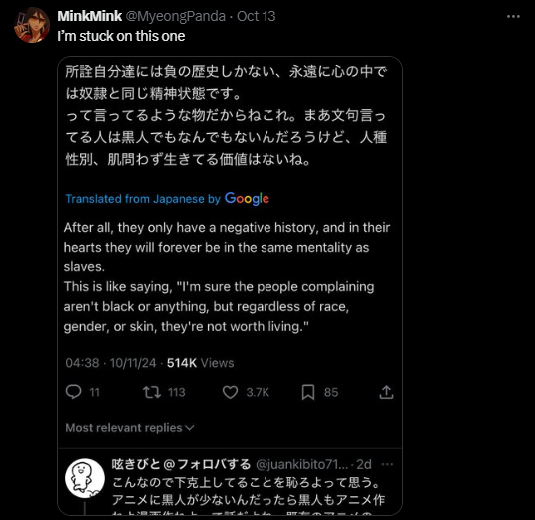
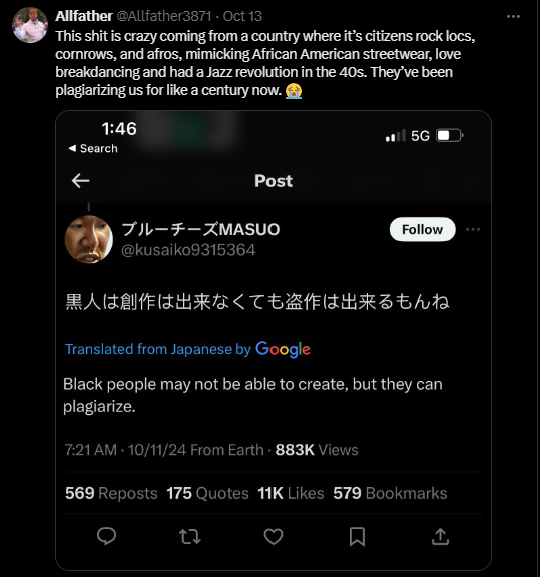
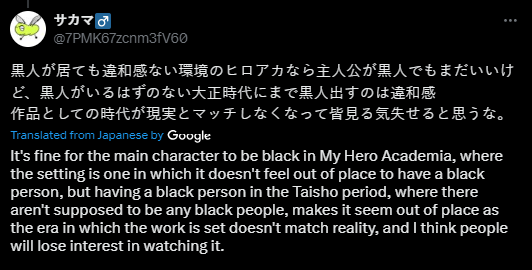
Which to the last tweet I have to say, just because we like to imagine characters as black does not mean that we actually want those characters to be black in the show. Are we not alloweed imaginations? I digress…
Then only a few months later, the teenage Dandadan artist was caught in the middle of this battle with their fan art of the main characters. Leading to an endless back and forth that included both spiteful comments like the ones seen over the Splatoon fan art, and users simply trying to reason with one another over their opinions. Of course the involvement of Japanese user’s made the argument even more intense as some believe that Japanese users have the final say on matters of art pertaining to anime simply because they are Japanese.
While on the pro-black fan art side, they argue that if anime characters have black characteristics – such as afros, locs, large noses and pronounced lips – in a way that sometimes mocks black culture, than why can’t someone draw anime characters as black for fun? Or why is it acceptable for anime to often be inspired by or borrow from aspects of black culture like music, dance, and fashion without acknowledging where those characteristics come from?
Or the fact that there are plenty of tanned anime characters that get to wash off their tans or reveal that they are actually fair skinned so that they are seen as acceptable?
But the biggest hypocrisy that the pro-black fan art community argues is why is their so much hate towards black fan art like the ones mentioned above yet people loved and shared their versions of Brazilian Miku, an alternative persona of the popular Vocaloid voice model Hatsune Miku. Which featured Miku dressed in clothing representing the Brazilian flag, jean shorts, curly hair and tanned skin.
In the art of one of the original Brazilian Miku artists @ErinArtista, who did not receive as much recognition as they should have for the trend, you can see features I’m talking about along with other food elements specific to Brazil. This is similarly seen in the version of Brazilian Miku that went viral redrawn by @Doodly_Sheery. This fan art sparked endless versions of Brazilian Miku as well as versions of Miku from countries around the world. From Malayasian Miku to Mexican Miku, to American Miku and beyond. Including multiple version drawn by Japanese artists as well.
Yet again there is a trend of Miku drawn as black specifically that seems to get a level of hate that other versions of her didn’t. Particularly with an African American Miku by @MOLENAIDE that caused some controversy.
With people arguing that she doesn’t have cultural clothing when this specific style is literally the basis for street fashion the entire world knows today. Tell me where you think baggy clothing with skin tight tube tops and jeans came from if not from early 2000s African American street culture and the music artists that popularized it.
This user says it better than I can:
As for the double standard of fan art in this space, I think @seeuchiyo says it best in their fan art of Brazilian Miku:
Despite this seemingly hypocritical approach still people argue that Brazilian Miku, like Spidersona’s, are an exception solely because they are seen as blank slates that anyone can attach personality too. Especially since in Miku’s case, she is literally just a stand in for a system that you can make music with and not a character with her own story and character arc.
Despite this sentiment though, there are people who argue that black versions of her are not acceptable but praise Brazilian Miku in the same breath. Even when the CEO of company that owns Vocaloid openly states that Miku is for everyone alongside a Black Lives Matter hashtag.
The Other Side of the Argument
From my perspective, fan artists are not saying that their art is better than the original, cosplayers aren’t saying their cosplays are how characters should be portrayed, these people are simply making fan art out of appreciation of characters with their own spin on it.
Why is this seen as more taboo than fan artists who turn beloved characters into gender bent versions of the original? Or monsters, animals, mythical creatures, or even Pokémon or Sonic characters? And I’m not talking about just Miku but also full fledged characters that have their own stories and even cultural histories yet get similar treatment without nearly as much outrage? When you look at these equally creative works of art, do you also believe that they are erasing Japanese ethnic features? Even when Japanese artists are the ones creating them?
I also want to clarify that I personally don’t condone people who try to “fix” characters or art as if to insinuate that a character needs to change to how they see fit solely because they believe they are right. Especially if there isn’t a critique on the art style or character itself. Nor am I saying taking a real person and drawing them in a way that “fixes” them is okay in any circumstance because it’s not and never will be.
However, if the intent is creative expression for fun and not to harm or belittle the existence of other people, than why has it turned into such a spiteful battle? I don’t have every perspective on this but I did get a few opinions from fans who expressed why they believe race bending fan art is not okay. I think we should be open to hearing alternative perspectives so please do not harass or attack these responders in anyway, we are each allowed our own opinion and I’m grateful they shared theirs. If you also would like to share your opinion on the subject in a respectful way, please feel free to do so in the comments of this video.
I get there is not enough representation , but whether the character belongs to a big company or a independent artist , its clearly not okay because they spend years drafting and thinking about every details and maybe they put a bit of themselves [in it] and when you come changing their character’s race like that , it feels like you are sending a message who says : ” Hello ! Your character is trash because they don’t fit my vision ! I’ll fix it ! ” And also, for seeing that with Disney, clearly i would prefer people make their own character ! [This] is how i perceive racebending ! It feels like they are saying to my face : ” Hey ! We don’t care about you and you don’t deserve [it even if] we spend time and effort crafting a character ! So just have this character but in black ! ” So yeah ! Clearly Racebending is no good to me and people should at least keep it to themselves -Atomic_herrmann_
Race-swapping a character that represents an idea, like Spider-Man, is different than race-swapping a character that is an individual whose race and culture are important to the story an artist wants to tell (something that matters to me as a multiracial creator). That context and culture should be respected by fan-creators. I feel much the same about art depicting a character as the opposite sex, or a different nationality, sexuality, etc. – Al
I’m a bit in the middle when it comes to race bending but I think that it isn’t ok due to the connotation it has. I think the topic of race can be a touchy subject. If I’m talking about anime specifically I’d say that not all cases should be considered “race bending.” Not all anime characters are Japanese, most of them are but not all of them. Some come from entirely different universes. Additionally, being darker or “black” isn’t entirely an indication of race. There are darker skinned Asians (some of them are mixed some aren’t). They exist they just aren’t pushed as much in the media cause of colorism. Growing up here most people prefer to see lighter skinned characters. – Anonymous
I think assigning a race ambiguous character a race is okay, or having a character as mixed race, but entirely changing a characters race for the sake of representation seems icky to me when there are so many black artists and characters you can support instead of racebending characters. There needs to be more black representation in media, but taking a pre existing character and changing the fundamentals of their identity does not do that. (i think it is different for gender swapping, because gender is something you can change in real life and it isn’t something that is inherited.) – Anonymous
I believe each of these opinions bring up valid points. Again I agree that claiming t o “fix” art is not okay no matter if it’s from a large corporation or a small independent creator. In terms of the representation argument and depicting actual ethnicities such as Japanese people in anime for example, that is the topic we’ll touch on next.
Mukokuseki
Anime and manga do feature characters who are inherently Japanese. Some of which are represented in ways that feel authentic to Japanese people and their features, and others in ways that seem to purposely not. This is because some of the designs are created with mukokuseki in mind.
Though I explore the concept of mukokuseki in detail in another video. (That you should watch after this one because it explores the complexity of anime character design in much more depth). I have to reinstate it in this video in order to break down just how impactful this concept of “statelessness” that is so often used in anime character design has lead to the conflicts over fan art that we’ve discussed so far.
Mukokuseki is essentially an “odorless” design that erases or minimizes racial or ethnic features in Japanese works to make them globally accessible. It is used not only in anime and manga but also in technology, novels, gaming, music and more and has lead to global success for Japan’s exports. At the same time, this concept in it’s desire to be universal often unintentionally promotes exclusionary practices in media by implying that the default is considered equal to White. This is seen in how some character designs use large colorful eyes (often blue or green), minimized facial features, fair skin, and light hair as the default for main characters. Features that many East Asian people would say does not fully represent how they look.
The appeal of Mukokseki is it’s use as escapism for Japanese audiences to imagine themselves in far off worlds away from their own ethnic features. Because of this, Aryan social media users claim that anime, a culturally Japanese medium, is actually a representation of their ideal society which they claim represents them. All while minimizing and ignoring the existence of countless people ranging from nations that make up East Asian and Pacific Islands as well as Latin and Afro-based countries with skin tones that are just as diverse and who also consume anime and manga. Some of these people are even partially responsible for bringing animated media to life thanks to global outsourcing, and yet their features are rarely are a part of the mukokuseki design process. Which ties directly back into the reality that anime like most other mediums, puts Eurocentric features on a pedestal even when they are attempting to steer away from representing individual ethnic groups.
In this quote from Black Bodies at Play: Race and Gender at the Edges of Subjectivity written by Sarah-Anne Gresham, she explores this by questioning:
“What does it mean when dark-skinned Black viewers, who have different power positions to White fans, can never “read themselves into” simplified and abstracted characters the same way White and other racialized viewers can, due to the presumption of a universalized character form that does not include them? What does it mean politically for anime, always-already outfitted with so much color in contrast to manga, to construct entire worlds devoid of Blackness? The configuration of these characters, no matter how abstracted, is never neutral but is implicated within the same set of social relations that order and arrange bodies in the real world.”
This is where everything comes full circle. In a medium that purposely tries to appeal to all while also continuing to ignore a large portion of the audience that consumes their content it is no wonder that black fans have created ways to express their desire to be seen in stories they love. Stories they believed were different from all the media that continue to ignore them simply because their designs were purposely made to not focus on one ethnic group, only for it to perpetuate the same biases that permeate every other medium they consume. So why is it a problem for this medium with countless popular works that purposely choose to not physically represent Japanese people are causing fans to yell at teenagers online for drawing characters with different traits?
When does mukokuseki stop becoming the reason anime characters are uniquely universal and start becoming an excuse to promote the opposite of statelessness? The issue is racism, colorism and bias unintentional or otherwise in these mediums and the storied history of erasure, orientalism, ignorance and imperialism that haunts our favorite mediums decades after many of these wars and issues first came to be.
I’m not saying that every anime uses this “odorless” design principle nor that every instance of black washed fan art is okay especially if it is covering up often underrepresented groups of people who are rarely shown in the first place. In series that do purposely try to portray characters as Japanese or other specific ethnicities with those ethnic features present, is it okay to race bend them in fan art? This I find trickier to answer because I don’t think actual ethnic identities should be forgotten or replaced especially if they are important to the story. I would feel uncomfortable if someone race bent Asirpa from Golden Kamuy for example because she is a rare example of native Ainu people in Japan that is hardly represented in the medium.
But characters purposely designed with mukokuseki in mind tend to lack ethnic features and even sometimes culture in the first place and when it comes solely to fan art done for personal use and expression, I believe it should be fine to race bend them as long as the intention is good.
If no one bats an eye at Rengoku having blond and red hair in Taisho period Japan (early 1900s) in Demon Slayer. When no one complains about an ending scene of an episode of Hunter x Hunter that makes Gon and Killua temporarily have darker skin for no explainable reason. When people use mukokuseki to explain why Scarlett Johanson being cast as Motoko Kusanagi in the live action adaptation of Ghost in the Shell. Yet don’t use that same argument for the casting of Inaki Godoy as Luffy in One Piece. Than why is it an issue for fans to have fun with character designs in their own way, if these artists who created these characters are also doing the same?
Conclusion
There is hypocrisy in fandom, there is also racism, discrimination, bias and hatred too. But one thing that is important to remember is that these aspects are not all that anime fandom are. Fandom is also acceptance and sharing the love you have for a franchise with like-minded people.
As a fan that doesn’t physically match the features that are prevalent in my favorite medium. I understand as much as anyone what it’s like to not fit this narrow standard of what people who like or talk about or make art about anime and manga should look like. And despite people questioning my validity as a fan every time I post a video. Despite the names people call me and the slurs they wish I answered to, I still make these videos. The sole reason that keeps me going is knowing that there are people out there that may relate to me in some way and that by seeing my videos they feel seen and understood.
I feel like a broken record saying this but I’m aware that I’m not the target demographic for anime or manga. As a black American woman I have very little say in what goes on in the Japanese mediums of anime and manga industry that is dominated by men, even the demographics made for women.
Yet because I express my opinions and enjoy race bent fan art fans think I or other creators somehow have authority over what goes in anime and manga. I appreciate that you think so highly of me and others but we don’t have as much as you think we do. However, just because I don’t have a lot power in these spaces doesn’t mean I’m not going to express my thoughts and opinions. Just like artists are not going to stop making art, cosplayers are not going to stop dressing up as their favorite characters. Fans are going to continue speaking their mind and creating what they want. As we should all be allowed to do as long it is not hurting others.
Remember that art is just art, it is expression and it is made to be talked about and critiqued. It is made to talk about and critique our own world as well and it will always reflect the endless issues we as humans have had and probably will have until we no longer exist. But as long we continue to make art, talk about it, and defend what we believe is right we can make small differences, and small differences compile into major differences. The fan art may be the work of a 16 year old artist simply having fun, but it can and has sparked conversations about underrepresentation in media and how that leads to real harm in reality where wars and genocides are being weighed against one another and given more or less coverage depending on the ethnic features and locations of the people who are suffering. Our stories and art reflect our realities more than we care to admit and in ways that are not always pleasant, but when we analyze them and fight back against crooked standards we can make differences, even from something as simple and harmless as fan art.
I have a fundraiser for PCRF linked. Even if you can’t support, if you are able to find some way to spread the word on what is going on in these countries and to these people who are constantly underrepresented and cared about, that makes a difference.
Thank you to the over 120 of you who provided your opinion on fan art as a fan, an artist, or a cosplayer. I could not fit all of your responses in this video but if you’d like to review all them I might make them available to read over on theanimetea.com (those who wanted to remain anonymous will be!). You’re responses left me crying in my room both out of joy just from seeing how fan art is important to you and sadness at all the ways it can also hurt us.
This is literally the most emotionally taxing set of videos I’ve ever made on this channel and I hope my intentions were clear in them. Do not harass or attack anyone online even if their opinion is different from yours. We should be allowed to have healthy conversations about things like this without worrying about personal and psychological safety.
Thank you to all my patrons for making this video possible. I used the funds I’ve made so far to buy resources and journal articles that I’ve used for these videos so I cannot thank you all enough. Watch my video exploring the complexities of mukokuseki and the complexities of racially ambiguous anime characters if you haven’t already. Be kind to one another and I’ll see you next time. Peace!
I will leave you with some more heartfelt responses from my survey that explore why art is important and impactful:
“I like to create something out of nothing. I enjoy the storytelling in anime and how it connects with the viewer. I wish for my art to do the same.” – @mynameisRafat
“It’s a great way to hone my skills as an artist and also I just enjoy talking about media I like and meeting people with similar interests, and art and cosplay communities are great for that.” – anonymous
“To express my love for the series/my series and to fill the void of content I want but don’t have externally” – anonymous
“I draw both fan art and do cosplay. I do these things as they are fun, a hobby or even a challenge. Cosplay that requires you to draw your own patterns, develop the outfit and all of that requires effort and thought. Sometimes they can be easy or a lot of work but it is the pay off at the end. For fan art it is the same – sometimes I just want to draw a character in X or maybe I’m trying a new technique or concept.” – @chibivesicle
“Doing art gives meaning to my life. I can live and put out thousands of things I need to in order to keep sanity. “ – Je papillon
“Character design and illustration is my full-time job. I’m an independent artist who has been drawing for as long as I could hold a crayon in my two-year-old fist, and I’ve worked hard to turn my passion into a sustainable career. I make art because I love creating and bringing smiles to others’ faces.” – Al
